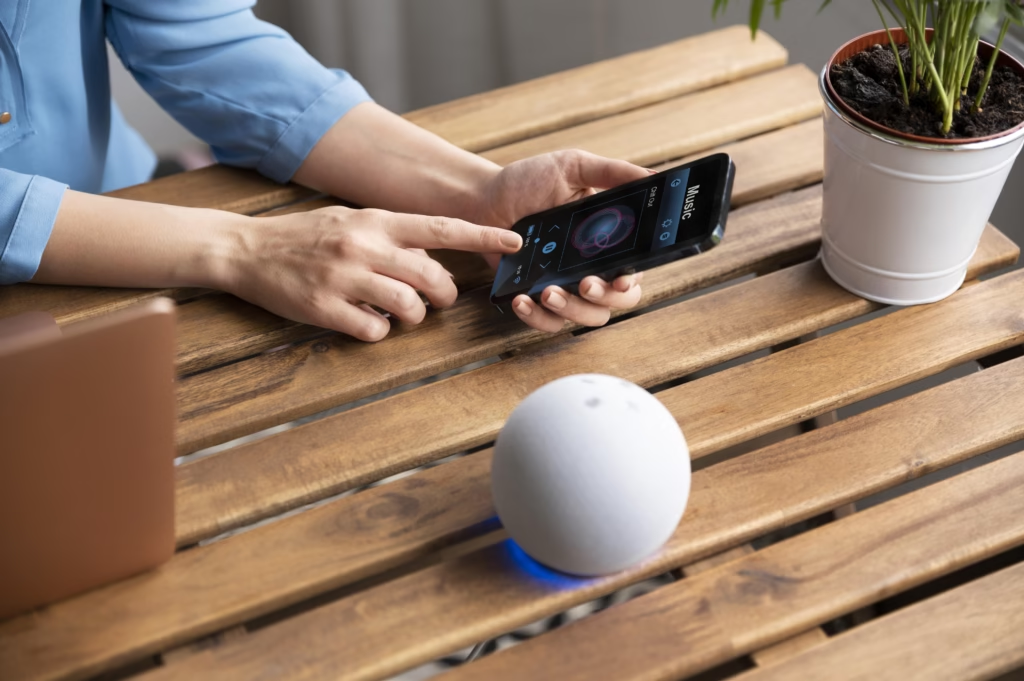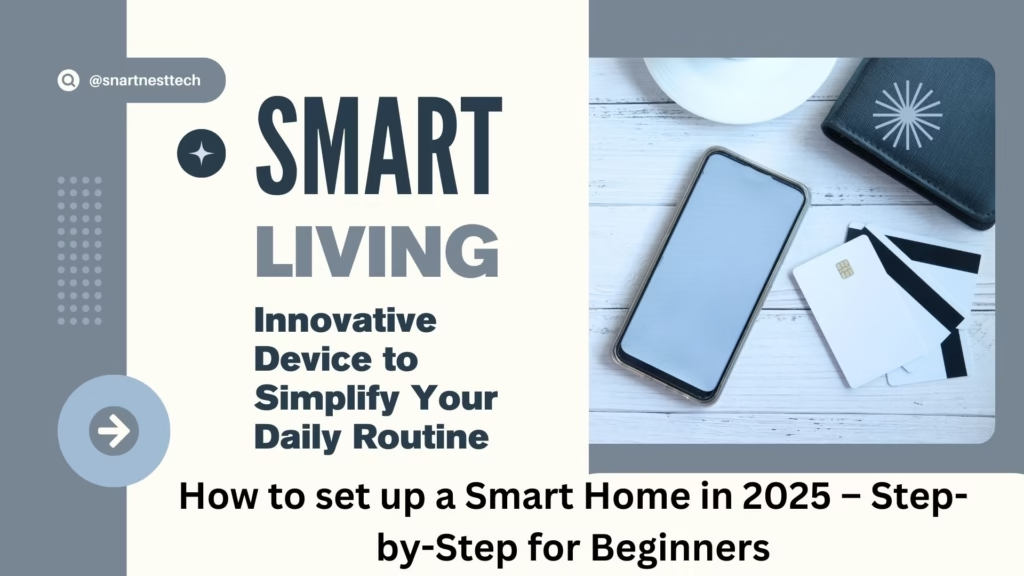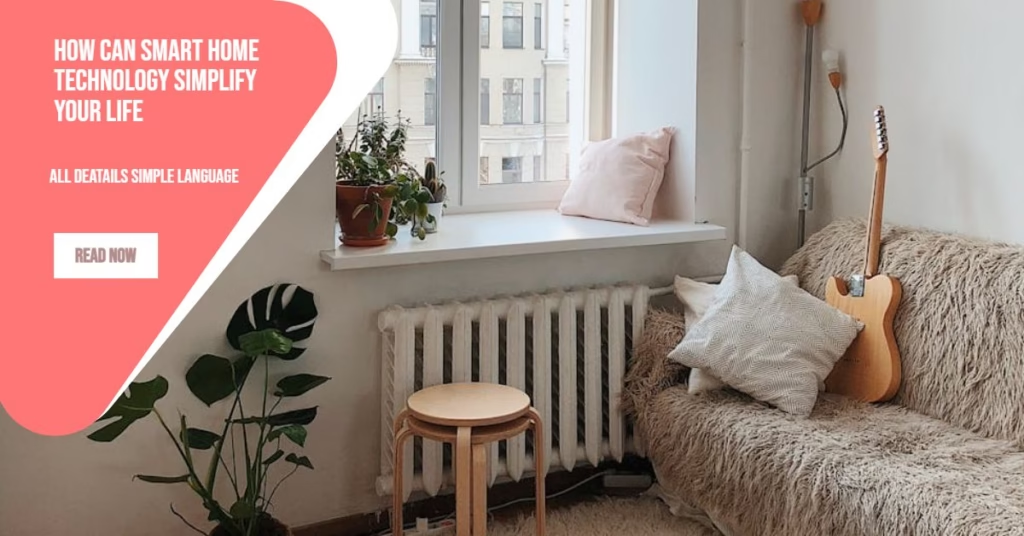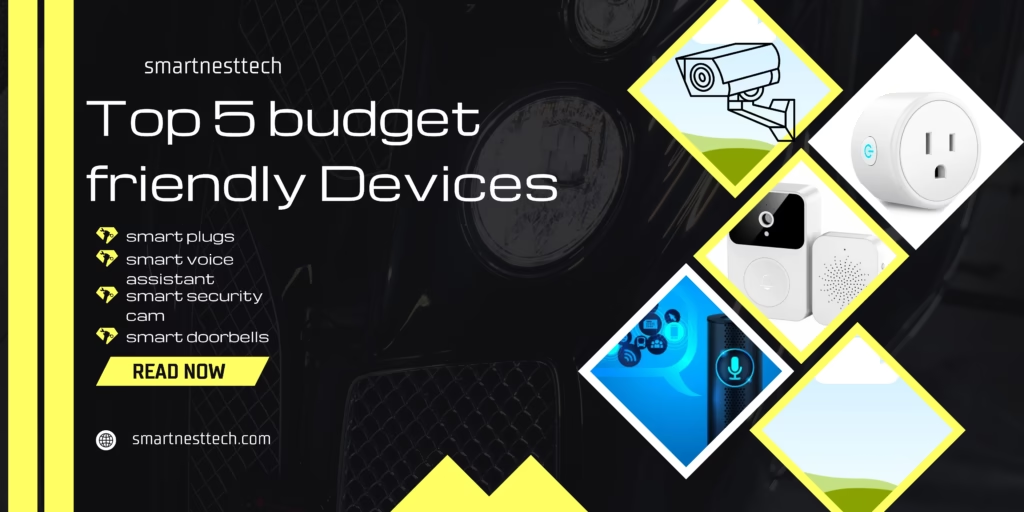Table of Contents
Introduction

Smart home technology is a system where the devices in your home work together through automation. These devices can be controlled with a single command or an app. For example, turning lights on or off, setting the AC to your desired temperature, monitoring cameras, or automating appliances—all of this is possible with a smart home setup.
For beginners, setting up smart home technology is very useful. The biggest advantage is that it helps save your valuable time, energy, and resources. You can start with basic devices and gradually improve your home experience over time.
Why Start Small and Affordable?
For beginners, starting small and budget-friendly with a smart home setup is very important. It allows you to test basic automation in your home and gradually move toward advanced setups.
- Low Investment: You can start with affordable devices like smart bulbs, smart plugs, and basic speakers, which are easily available in the market.
- Easy Setup: Avoid complicated systems and begin with simple plug-and-play devices that are beginner-friendly. This gives you experience and confidence for future advanced smart home setups.
- Learning Curve: Setting up all advanced devices at once can be tricky. Starting small gives you the time to understand and learn the technology step by step.
What Will You Learn in This Guide?
- Setting Basic Goals: Understand your priorities for a smart home—whether it’s convenience, security, or energy savings.
- Essential Device Setup: Learn quick steps to set up smart bulbs, plugs, and speakers.
- Automation Routines: Discover how to create smart routines to make your homework automatically and efficiently.
A smart home setup isn’t just about gadgets—it’s an intelligent solution to make your life easier, more organized, and highly efficient. We promise you’ll truly enjoy the benefits of a smart home! 😊
Essential Devices for Beginners
Starting a smart home setup requires some basic devices that are essential for beginners. These devices not only make your home smarter but also simplify and make your daily tasks more convenient. Let’s look at the devices you can start with for your smart home setup.
- Smart Speakers/Voice Assistants:
Smart speakers allow you to control your gadgets with just one voice command. Alexa, Google Nest, and Apple Home Pod are great options for everyday use.
- You can set timers, play music, and control other smart devices in your home using these speakers.
- Example: Say, “Alexa, turn on the TV,” or “Hey Google, play my favorite song playlist.”
- Smart Plugs:
Smart plugs make it easy to control appliances like fans, chargers, and kitchen gadgets.
- If you want to automate appliances on a fixed schedule, smart plugs are the best option.
- Example: Set a timer for your coffee maker to turn on or automate the TV plug for specific hours.
- Smart Lights:
Smart lights are energy-efficient and can be customized to match your mood. You can turn them on or off whenever needed.
- You can adjust their brightness or even change the colour (e.g., for party mode, relaxing evenings, or bedtime).
- Example: Philips Hue or Wipro Smart Bulbs are beginner-friendly and affordable options.
- Smart Cameras/Security Devices:
Smart cameras are a must-have for home safety.
- They let you monitor live video feeds, get alerts for unauthorized activity, and save footage in cloud storage. This makes you feel safe, even when you’re away from home.
- Example: Ring Doorbell and TP-Link Security Cameras are budget-friendly and reliable options.
Budget-Friendly Device Recommendations:
- Smart Speaker: Amazon Echo Dot or Google Nest Mini (starting around ₹3,000).
- Smart Plug: Wipro Smart Plug or TP-Link Smart Plug (starting around ₹1,500).
- Smart Lights: Philips Hue or Syska Smart Bulbs (starting around ₹800).
- Smart Cameras: Mi Home Security Camera or TP-Link Tapo (starting around ₹2,500).
All these devices are available at affordable prices and are perfect for beginners. You can start with these basic devices and gradually expand your smart home setup. Smart home technology begins here—step by step, you can make your home smarter and your life easier! 😊
Preparing Your Home for Smart Devices
To make your smart home setup smooth and effective, you need to prepare your home properly. Let’s see what steps you should take before installing smart devices.
- Stable Wi-Fi Connection is Essential for Devices to Work
Smart home devices depend entirely on Wi-Fi, so having a strong and stable connection is very important. The better your network, the smoother your devices will work.
- Tips for Improving Speed and Coverage:
- Place your router in a central location for maximum coverage.
- Keep the router away from walls or metal objects that can block the signal.
- Use range extenders or mesh Wi-Fi systems, especially if you have a large home.
- Check If Devices are Compatible with Your Platform
Before buying devices, make sure they are compatible with your smart home platform.
- Common Platforms: The top platforms are Amazon Alexa, Google Home, and Apple HomeKit.
- Example: Choose Alexa-enabled smart plugs or lights that are compatible with Google Nest.
- If your devices integrate seamlessly with your platform, the setup process will be much easier.
- Download Necessary Apps
Every smart device comes with its own dedicated app, which helps you set up and manage the device easily.
- Before Starting:
- Install the required apps for your devices (e.g., Alexa App, Google Home App, or Apple Home App).
- Follow the step-by-step instructions provided in the app.
- Ensure your smartphone has the latest software updates to avoid any issues.
By following these preparation steps, your smart home setup process will be hassle-free, and your devices will start working efficiently. Get your home ready for smart technology and enjoy the benefits it offers! 😊
Step-by-Step Device Setup
Setting up smart home devices is very simple; you just need to follow a step-by-step process. This guide will show you how to set up smart speakers, lights, plugs, and cameras easily. These steps are very important for a smooth experience.
- Smart Speaker/Voice Assistant Setup:
A smart speaker is the centrepiece of your smart home setup. Here’s how to set it up:
- Unboxing and connecting to Wi-Fi:
- Unbox your smart speaker and plug it into a power outlet.
- Download the app for your speaker (e.g., Alexa or Google Home) and follow the instructions to connect it to Wi-Fi.
- Testing Voice Commands:
- Once the setup is complete, test your speaker with a few voice commands.
- Example: “Hey Google, what’s the weather today?” or “Alexa, play my favorite music.”
- Smart Lights Setup:
Smart lights help you create a flexible and energy-efficient lighting system at home.
- Installing Smart Bulbs or Switches:
- Replace your regular bulb with a smart bulb and turn on the switch.
- Connect the bulb to its app (e.g., Philips Hue app) by following the instructions.
- Setting Schedules and Scenes:
- Automate your lighting by setting schedules in the app.
- Example: Create a “Relax Mode” with dim lights or a “Morning Mode” with bright lights.
- Smart Plugs Setup:
Smart plugs make regular appliances smarter and easier to control.
- Plugging In and Linking with the App:
- Plug the smart plug into a wall socket and connect it to Wi-Fi using the app.
- Examples of Automation:
- Add your coffee maker to your morning routine so it starts automatically.
- Set specific times for your phone charger to turn on and off to save energy.
- Smart Camera Setup:
Smart cameras are highly effective for home security. Here’s how to set them up:
- Placement Tips for Optimal Coverage:
- Place the camera near entry points, main doors, or open areas for the best coverage.
- Ensure there are no blind spots in its field of view.
- Connecting and Testing Live Feeds:
- Add the camera to its app and connect it to Wi-Fi.
- Test the live video feed and enable alerts for security purposes.
By following these steps, your smart home setup will be hassle-free and perfectly organized. Once you’ve set up these devices, you’ll experience a whole new level of convenience and joy in your daily life! 😊
Automating Your Smart Home
Smart home technology allows you to make your home truly intelligent, where devices work automatically based on your schedule or location. Let’s see how you can start automating your smart home.
- Creating Basic Routines:
Routines let you control multiple devices at once, making your daily life easier. These routines can work on a regular schedule automatically.
- Morning Routines:
- Example: As soon as you wake up, the AC turns off, the lights turn on, and the coffee maker starts brewing.
- Good Night Mode:
- Example: With just one command, all doors lock, lights dim, and unnecessary appliances turn off.
- You can easily set these routines using voice assistant apps like Alexa or Google Home.
- Using Geofencing for Automated Tasks:
Geofencing tracks your location and makes smart home devices work automatically.
- How It Works:
- When you approach your home, the lights turn on, and the AC adjusts to your comfort level.
- When you leave home, the lights and appliances turn off, saving energy.
- Setup Tips:
- Enable the geofencing feature in your smart home app and sync it with your mobile’s GPS.
- Introduction to IFTTT for Advanced Automation:
IFTTT (If This Then That) lets you create advanced automation, connecting your devices to work together seamlessly.
- Examples of Advanced Automation:
- If motion is detected at the main door, a notification is sent to your phone, and the porch light turns on.
- If the weather forecast shows rain, your smart blinds close automatically.
- Getting Started:
- Download the IFTTT app, link it to your smart home account, and try ready-made automation or create custom rules.
These features make your smart home powerful, efficient, and stress-free. With automation, you’ll need to do less manual work, and your home will function seamlessly to suit your lifestyle! 😊
Troubleshooting Common Issues
Smart home devices usually work seamlessly, but sometimes minor issues can occur. These problems can be easily solved if you follow the correct steps. Let’s look at some common problems with smart home devices and their solutions.
- Connectivity Problems:
Smart devices depend on Wi-Fi, so connectivity issues are common.
- Wi-Fi Issues:
- Check if your Wi-Fi connection is strong. Weak signals can prevent devices from connecting.
- Reset your router and place the device within the Wi-Fi range.
- App Syncing Problems:
- Make sure your device and app are updated. Older versions can cause syncing issues.
- Remove the device from the app and re-add it, then manually verify Wi-Fi settings.
- Device Unresponsiveness:
Sometimes devices stop responding. These simple steps can help fix the issue:
- Check Power Supply:
- Ensure the devices are properly plugged in and the power supply is working.
- Restart the Device:
- Turn the device off and wait 1-2 minutes before restarting it.
- Verify App Settings:
- Check the app settings to ensure the device is properly configured and no automation routines are disabled.
- How to Reset Devices and When to Seek Support:
If the above solutions don’t work, resetting the device may help.
- Reset Steps:
- Refer to the device manual to understand how to use the reset button.
- Typically, pressing the reset button for 5-10 seconds restores the device to factory settings.
- When to Seek Support:
- If resetting doesn’t fix the issue, contact the brand’s customer support.
- Check for replacement options if the device is under warranty.
These troubleshooting tips will help your smart home devices function smoothly again. Most minor issues can be resolved easily, ensuring your setup continues hassle-free! 😊
Conclusion
Starting a smart home setup is very easy, and by taking small steps, you can gradually make your home smarter. Starting with basic devices, you can then move to more advanced ones, which will greatly improve your experience.
As you get more comfortable, you can explore more advanced options. Personalizing your smart home setup is entirely your choice, and the technology will help make your daily life more convenient and efficient.
Call-to-action: Start your smart home journey today, and follow SmartNestTech.com for more tips, tricks, and product recommendations! 😊
FAQs:
- What is a smart home setup, and how does it work?
A smart home setup connects devices in your home (like lights, speakers, and appliances) to the internet, allowing you to control them using apps, voice assistants, or automation routines. It simplifies tasks and improves efficiency.
- What are the essential devices for a beginner’s smart home setup?
The best devices to start with are:
- Smart Speakers/Voice Assistants (e.g., Amazon Alexa, Google Nest)
- Smart Plugs (for automating appliances)
- Smart Lights (for energy-efficient lighting)
- Smart Cameras (for home security)
- Do I need technical knowledge to set up a smart home?
Not at all! Most smart devices come with step-by-step instructions in their apps. These setups are beginner-friendly, and you can easily follow the guide provided in your blog to get started.
- How much does a basic smart home setup cost?
A basic setup can start as low as ₹5,000–₹10,000. You can begin with affordable devices like smart plugs, bulbs, and entry-level speakers like the Echo Dot or Google Nest Mini.
- Is my Wi-Fi connection important for a smart home?
Yes, smart devices rely on Wi-Fi to function. A stable and strong Wi-Fi connection ensures that your devices respond quickly and work without interruptions.
- Can I automate tasks with a smart home setup?
Yes, smart home technology allows automation through routines and geofencing.
- Routines: For example, setting a “Good Night” mode that turns off lights and locks doors.
- Geofencing: Automates tasks based on your location, like turning on lights when you’re near home.
- What happens if my device stops working or doesn’t respond?
You can follow these troubleshooting steps:
- Check your Wi-Fi connection.
- Restart the device or app.
- Reset the device if the problem persists, and contact customer support if needed.
- Are smart home devices secure?
Yes, but it’s important to secure your devices with:
- Strong passwords.
- Updated software.
- Using trusted brands with good security features.
- Can I upgrade my smart home setup later?
Absolutely! Start with basic devices and add more advanced ones over time, like smart thermostats, advanced cameras, or home automation hubs.
- Where can I learn more about smart home products and setup tips?
Follow SmartNestTech.com for regular tips, tricks, product recommendations, and beginner-friendly guides to make your smart home journey smoother.
Related
Discover more from
Subscribe to get the latest posts sent to your email.



